Building Project Evaluation: Development and Investment Study
VerifiedAdded on 2022/11/19
|22
|5258
|486
Report
AI Summary
This report presents a comprehensive feasibility study for a shopping centre building project, analyzing both development and investment aspects. The first part focuses on the development stage, including market overviews, legal constraints, and project constraints such as encumbrances, zoning, and environmental factors. The second part delves into the investment perspective, examining financial considerations like capitalization rates, rental growth forecasts, taxation implications, risk assessment, and sustainability. The report assesses the project's viability through financial forecasts and estimations, including cash flows and internal rate of return, to determine the most viable building project for Pty Developments Limited. The study incorporates current and future market analysis, legal implications, and economic considerations to provide a well-rounded evaluation of the project's potential for success.
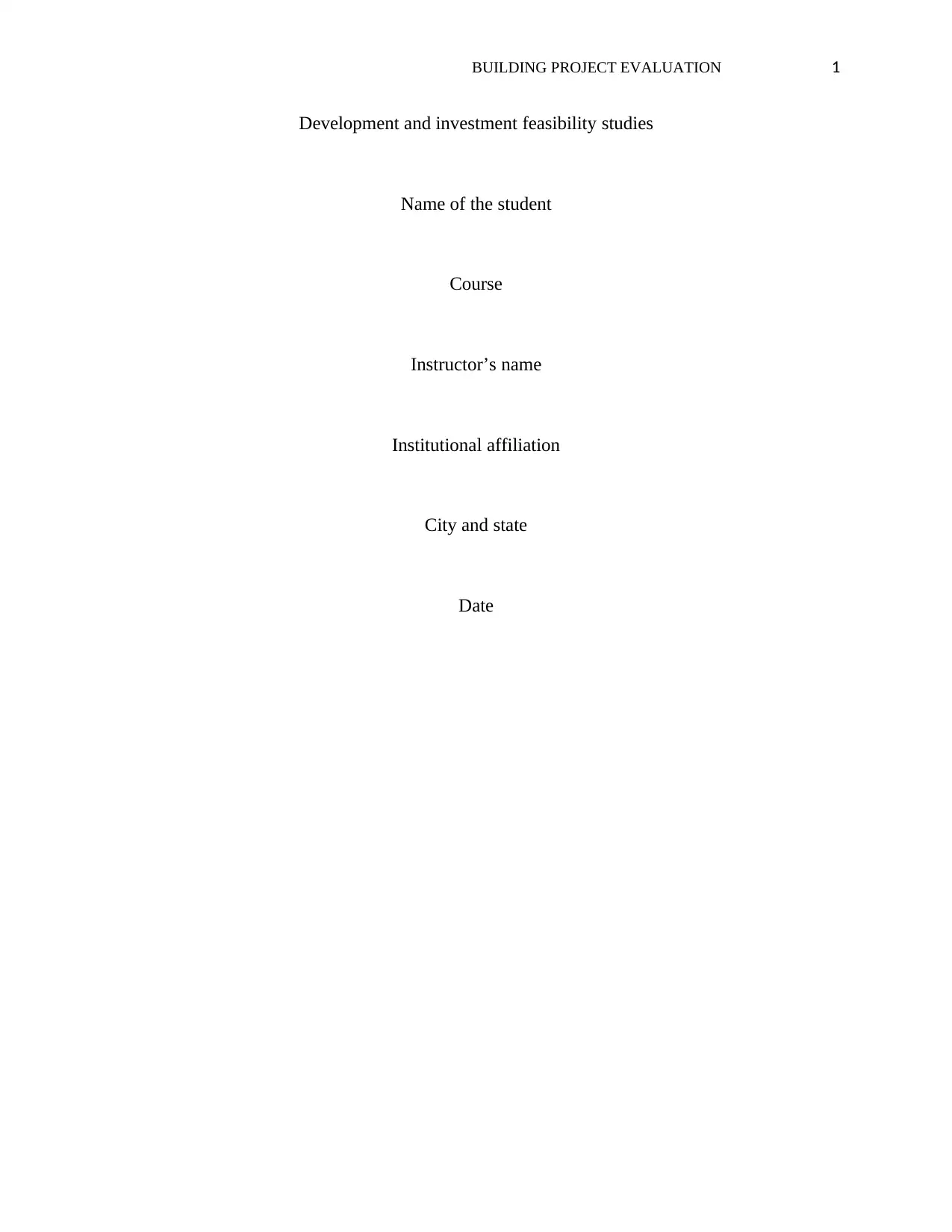
BUILDING PROJECT EVALUATION 1
Development and investment feasibility studies
Name of the student
Course
Instructor’s name
Institutional affiliation
City and state
Date
Development and investment feasibility studies
Name of the student
Course
Instructor’s name
Institutional affiliation
City and state
Date
Paraphrase This Document
Need a fresh take? Get an instant paraphrase of this document with our AI Paraphraser
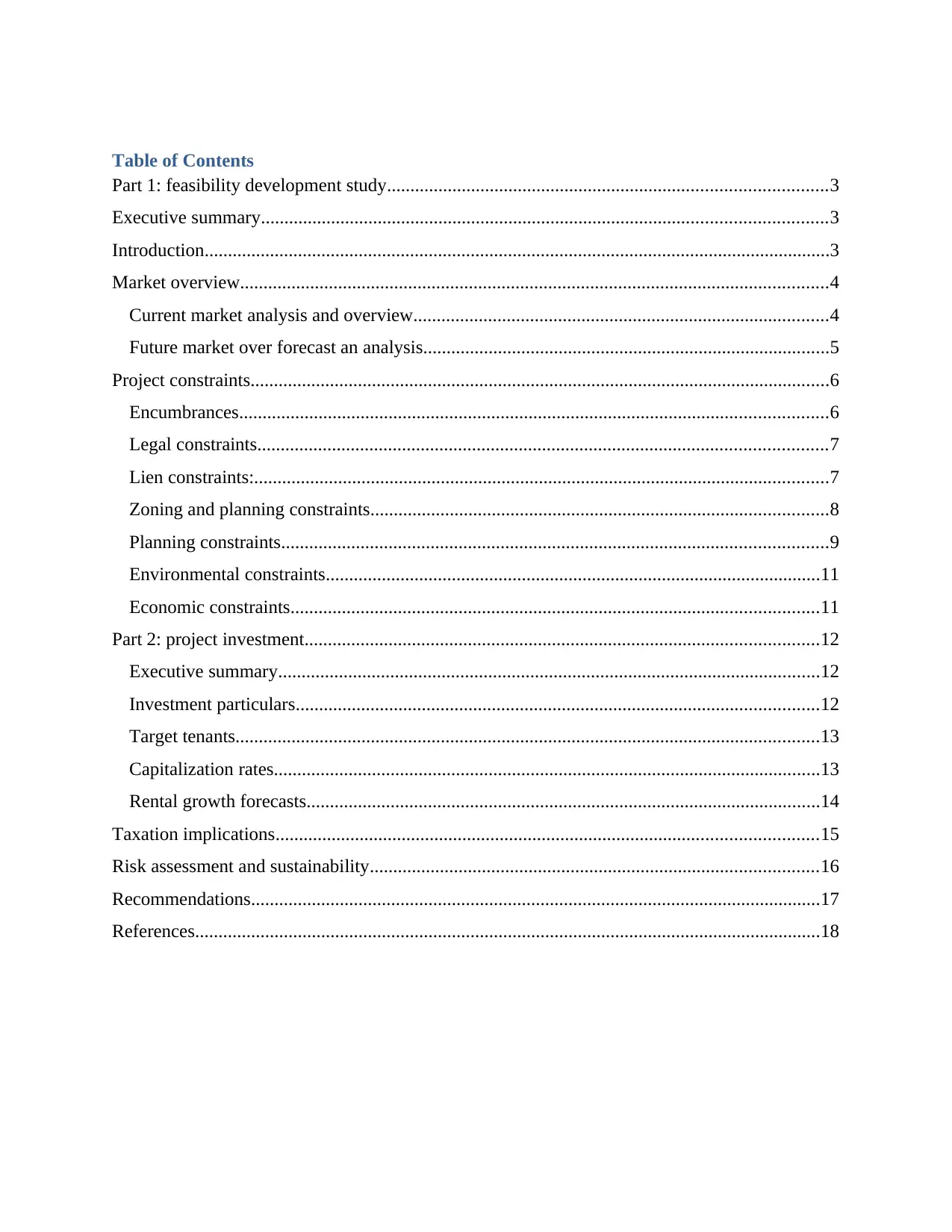
Table of Contents
Part 1: feasibility development study..............................................................................................3
Executive summary.........................................................................................................................3
Introduction......................................................................................................................................3
Market overview..............................................................................................................................4
Current market analysis and overview.........................................................................................4
Future market over forecast an analysis.......................................................................................5
Project constraints............................................................................................................................6
Encumbrances..............................................................................................................................6
Legal constraints..........................................................................................................................7
Lien constraints:...........................................................................................................................7
Zoning and planning constraints..................................................................................................8
Planning constraints.....................................................................................................................9
Environmental constraints..........................................................................................................11
Economic constraints.................................................................................................................11
Part 2: project investment..............................................................................................................12
Executive summary....................................................................................................................12
Investment particulars................................................................................................................12
Target tenants.............................................................................................................................13
Capitalization rates.....................................................................................................................13
Rental growth forecasts..............................................................................................................14
Taxation implications....................................................................................................................15
Risk assessment and sustainability................................................................................................16
Recommendations..........................................................................................................................17
References......................................................................................................................................18
Part 1: feasibility development study..............................................................................................3
Executive summary.........................................................................................................................3
Introduction......................................................................................................................................3
Market overview..............................................................................................................................4
Current market analysis and overview.........................................................................................4
Future market over forecast an analysis.......................................................................................5
Project constraints............................................................................................................................6
Encumbrances..............................................................................................................................6
Legal constraints..........................................................................................................................7
Lien constraints:...........................................................................................................................7
Zoning and planning constraints..................................................................................................8
Planning constraints.....................................................................................................................9
Environmental constraints..........................................................................................................11
Economic constraints.................................................................................................................11
Part 2: project investment..............................................................................................................12
Executive summary....................................................................................................................12
Investment particulars................................................................................................................12
Target tenants.............................................................................................................................13
Capitalization rates.....................................................................................................................13
Rental growth forecasts..............................................................................................................14
Taxation implications....................................................................................................................15
Risk assessment and sustainability................................................................................................16
Recommendations..........................................................................................................................17
References......................................................................................................................................18
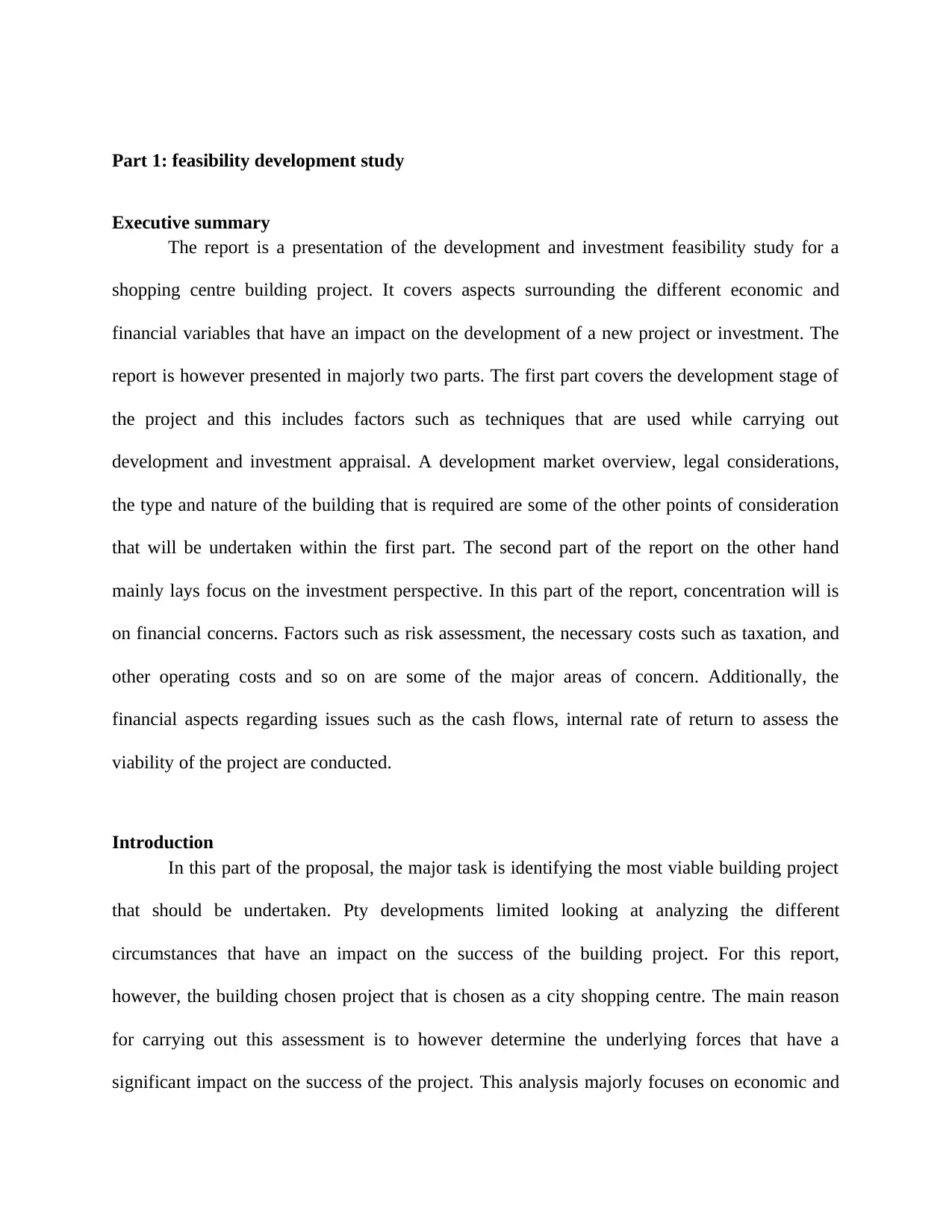
Part 1: feasibility development study
Executive summary
The report is a presentation of the development and investment feasibility study for a
shopping centre building project. It covers aspects surrounding the different economic and
financial variables that have an impact on the development of a new project or investment. The
report is however presented in majorly two parts. The first part covers the development stage of
the project and this includes factors such as techniques that are used while carrying out
development and investment appraisal. A development market overview, legal considerations,
the type and nature of the building that is required are some of the other points of consideration
that will be undertaken within the first part. The second part of the report on the other hand
mainly lays focus on the investment perspective. In this part of the report, concentration will is
on financial concerns. Factors such as risk assessment, the necessary costs such as taxation, and
other operating costs and so on are some of the major areas of concern. Additionally, the
financial aspects regarding issues such as the cash flows, internal rate of return to assess the
viability of the project are conducted.
Introduction
In this part of the proposal, the major task is identifying the most viable building project
that should be undertaken. Pty developments limited looking at analyzing the different
circumstances that have an impact on the success of the building project. For this report,
however, the building chosen project that is chosen as a city shopping centre. The main reason
for carrying out this assessment is to however determine the underlying forces that have a
significant impact on the success of the project. This analysis majorly focuses on economic and
Executive summary
The report is a presentation of the development and investment feasibility study for a
shopping centre building project. It covers aspects surrounding the different economic and
financial variables that have an impact on the development of a new project or investment. The
report is however presented in majorly two parts. The first part covers the development stage of
the project and this includes factors such as techniques that are used while carrying out
development and investment appraisal. A development market overview, legal considerations,
the type and nature of the building that is required are some of the other points of consideration
that will be undertaken within the first part. The second part of the report on the other hand
mainly lays focus on the investment perspective. In this part of the report, concentration will is
on financial concerns. Factors such as risk assessment, the necessary costs such as taxation, and
other operating costs and so on are some of the major areas of concern. Additionally, the
financial aspects regarding issues such as the cash flows, internal rate of return to assess the
viability of the project are conducted.
Introduction
In this part of the proposal, the major task is identifying the most viable building project
that should be undertaken. Pty developments limited looking at analyzing the different
circumstances that have an impact on the success of the building project. For this report,
however, the building chosen project that is chosen as a city shopping centre. The main reason
for carrying out this assessment is to however determine the underlying forces that have a
significant impact on the success of the project. This analysis majorly focuses on economic and
⊘ This is a preview!⊘
Do you want full access?
Subscribe today to unlock all pages.

Trusted by 1+ million students worldwide
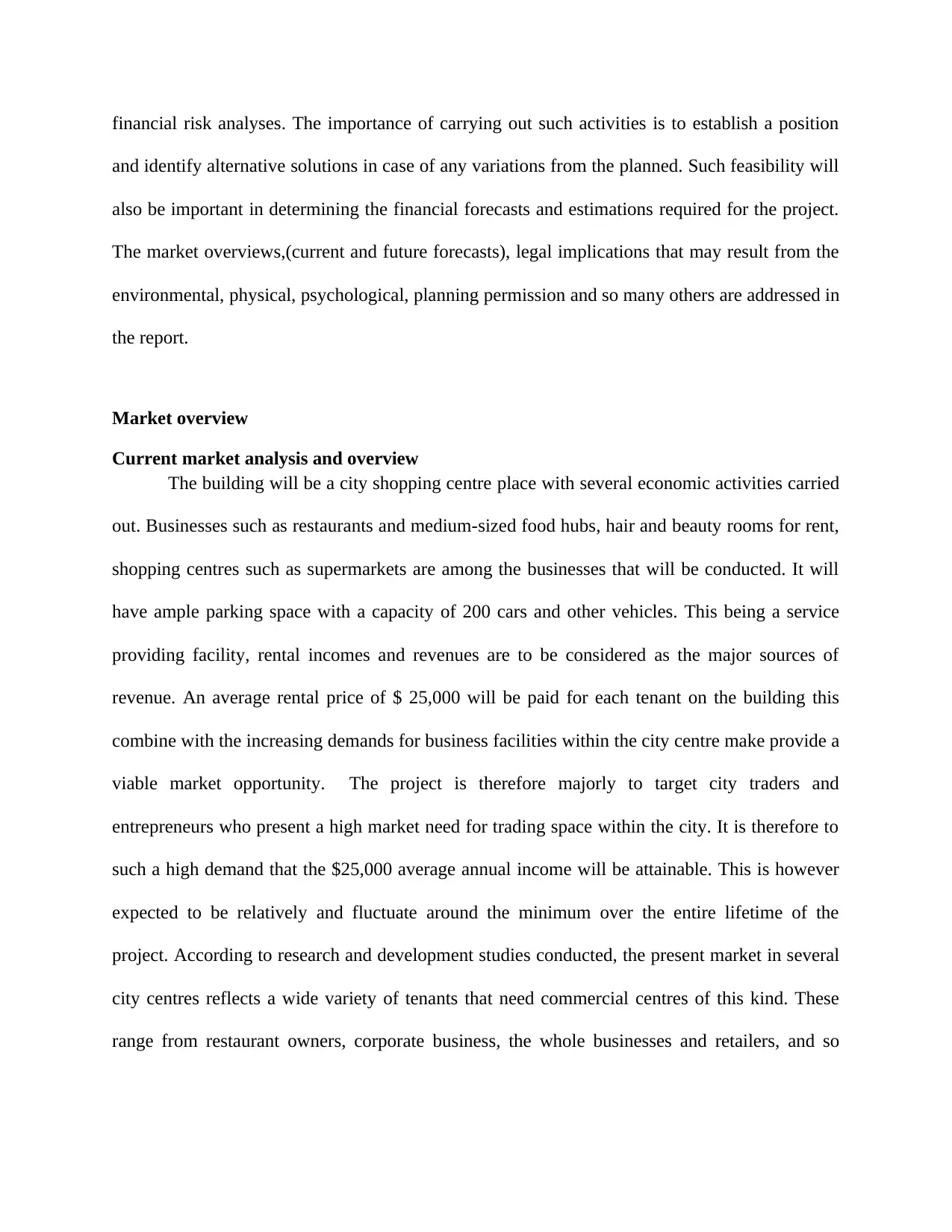
financial risk analyses. The importance of carrying out such activities is to establish a position
and identify alternative solutions in case of any variations from the planned. Such feasibility will
also be important in determining the financial forecasts and estimations required for the project.
The market overviews,(current and future forecasts), legal implications that may result from the
environmental, physical, psychological, planning permission and so many others are addressed in
the report.
Market overview
Current market analysis and overview
The building will be a city shopping centre place with several economic activities carried
out. Businesses such as restaurants and medium-sized food hubs, hair and beauty rooms for rent,
shopping centres such as supermarkets are among the businesses that will be conducted. It will
have ample parking space with a capacity of 200 cars and other vehicles. This being a service
providing facility, rental incomes and revenues are to be considered as the major sources of
revenue. An average rental price of $ 25,000 will be paid for each tenant on the building this
combine with the increasing demands for business facilities within the city centre make provide a
viable market opportunity. The project is therefore majorly to target city traders and
entrepreneurs who present a high market need for trading space within the city. It is therefore to
such a high demand that the $25,000 average annual income will be attainable. This is however
expected to be relatively and fluctuate around the minimum over the entire lifetime of the
project. According to research and development studies conducted, the present market in several
city centres reflects a wide variety of tenants that need commercial centres of this kind. These
range from restaurant owners, corporate business, the whole businesses and retailers, and so
and identify alternative solutions in case of any variations from the planned. Such feasibility will
also be important in determining the financial forecasts and estimations required for the project.
The market overviews,(current and future forecasts), legal implications that may result from the
environmental, physical, psychological, planning permission and so many others are addressed in
the report.
Market overview
Current market analysis and overview
The building will be a city shopping centre place with several economic activities carried
out. Businesses such as restaurants and medium-sized food hubs, hair and beauty rooms for rent,
shopping centres such as supermarkets are among the businesses that will be conducted. It will
have ample parking space with a capacity of 200 cars and other vehicles. This being a service
providing facility, rental incomes and revenues are to be considered as the major sources of
revenue. An average rental price of $ 25,000 will be paid for each tenant on the building this
combine with the increasing demands for business facilities within the city centre make provide a
viable market opportunity. The project is therefore majorly to target city traders and
entrepreneurs who present a high market need for trading space within the city. It is therefore to
such a high demand that the $25,000 average annual income will be attainable. This is however
expected to be relatively and fluctuate around the minimum over the entire lifetime of the
project. According to research and development studies conducted, the present market in several
city centres reflects a wide variety of tenants that need commercial centres of this kind. These
range from restaurant owners, corporate business, the whole businesses and retailers, and so
Paraphrase This Document
Need a fresh take? Get an instant paraphrase of this document with our AI Paraphraser
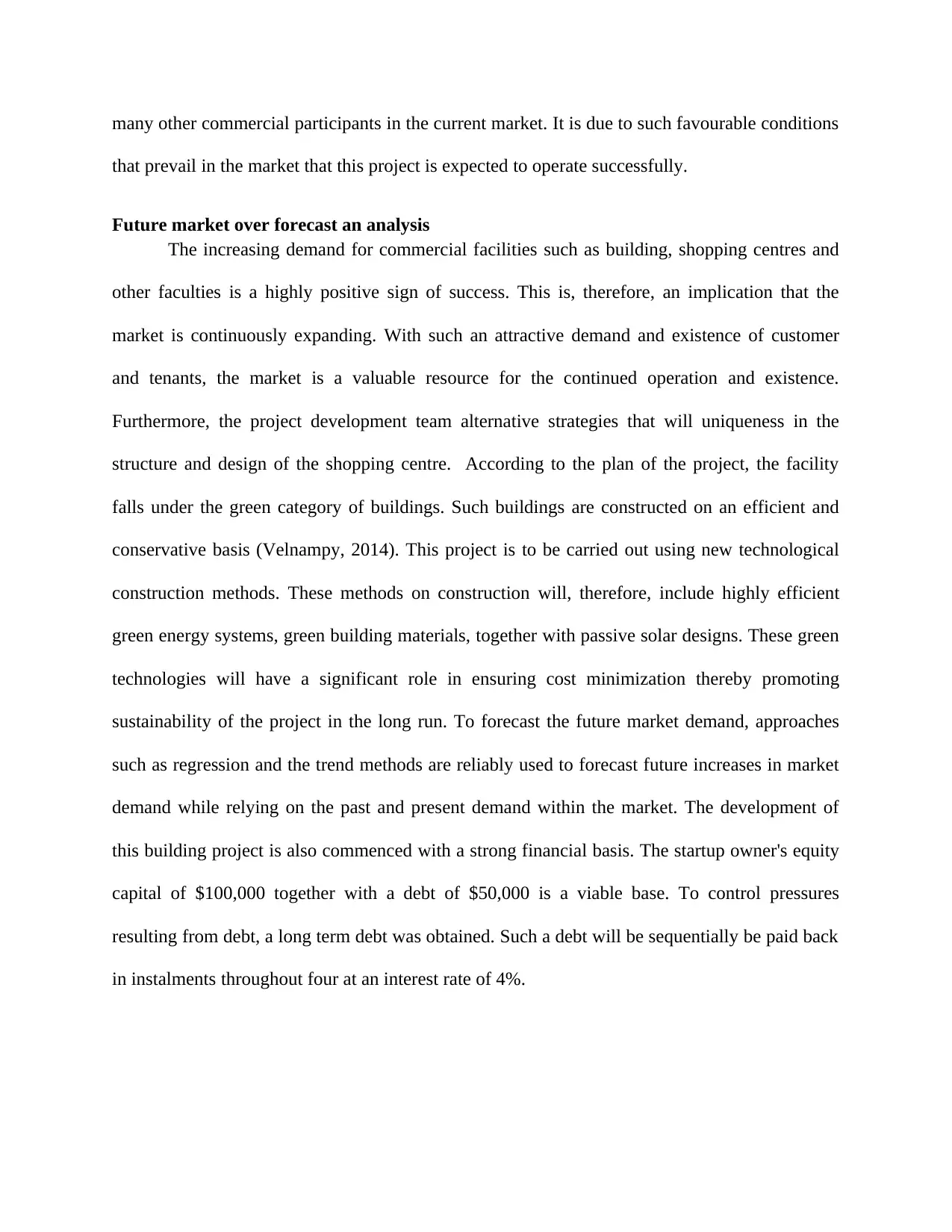
many other commercial participants in the current market. It is due to such favourable conditions
that prevail in the market that this project is expected to operate successfully.
Future market over forecast an analysis
The increasing demand for commercial facilities such as building, shopping centres and
other faculties is a highly positive sign of success. This is, therefore, an implication that the
market is continuously expanding. With such an attractive demand and existence of customer
and tenants, the market is a valuable resource for the continued operation and existence.
Furthermore, the project development team alternative strategies that will uniqueness in the
structure and design of the shopping centre. According to the plan of the project, the facility
falls under the green category of buildings. Such buildings are constructed on an efficient and
conservative basis (Velnampy, 2014). This project is to be carried out using new technological
construction methods. These methods on construction will, therefore, include highly efficient
green energy systems, green building materials, together with passive solar designs. These green
technologies will have a significant role in ensuring cost minimization thereby promoting
sustainability of the project in the long run. To forecast the future market demand, approaches
such as regression and the trend methods are reliably used to forecast future increases in market
demand while relying on the past and present demand within the market. The development of
this building project is also commenced with a strong financial basis. The startup owner's equity
capital of $100,000 together with a debt of $50,000 is a viable base. To control pressures
resulting from debt, a long term debt was obtained. Such a debt will be sequentially be paid back
in instalments throughout four at an interest rate of 4%.
that prevail in the market that this project is expected to operate successfully.
Future market over forecast an analysis
The increasing demand for commercial facilities such as building, shopping centres and
other faculties is a highly positive sign of success. This is, therefore, an implication that the
market is continuously expanding. With such an attractive demand and existence of customer
and tenants, the market is a valuable resource for the continued operation and existence.
Furthermore, the project development team alternative strategies that will uniqueness in the
structure and design of the shopping centre. According to the plan of the project, the facility
falls under the green category of buildings. Such buildings are constructed on an efficient and
conservative basis (Velnampy, 2014). This project is to be carried out using new technological
construction methods. These methods on construction will, therefore, include highly efficient
green energy systems, green building materials, together with passive solar designs. These green
technologies will have a significant role in ensuring cost minimization thereby promoting
sustainability of the project in the long run. To forecast the future market demand, approaches
such as regression and the trend methods are reliably used to forecast future increases in market
demand while relying on the past and present demand within the market. The development of
this building project is also commenced with a strong financial basis. The startup owner's equity
capital of $100,000 together with a debt of $50,000 is a viable base. To control pressures
resulting from debt, a long term debt was obtained. Such a debt will be sequentially be paid back
in instalments throughout four at an interest rate of 4%.
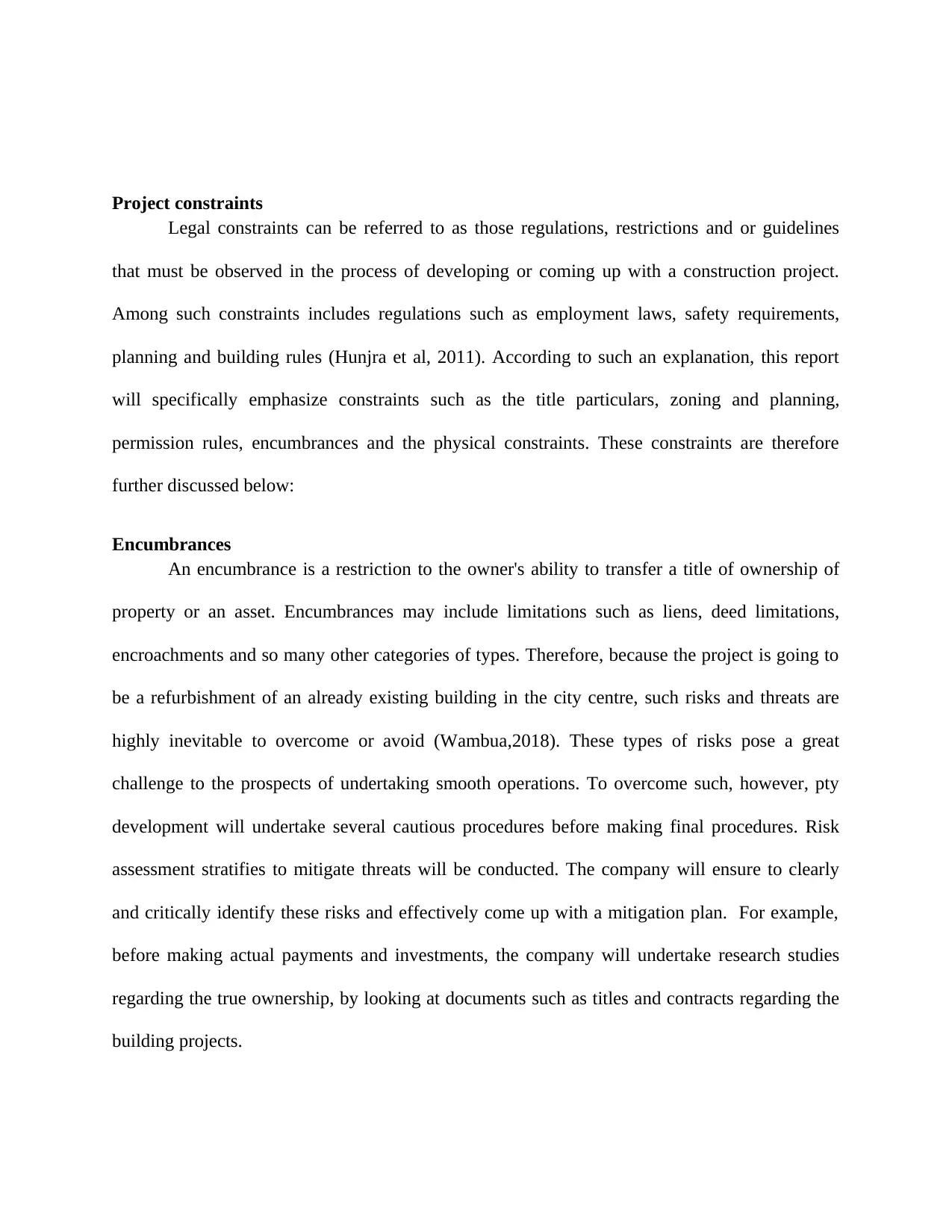
Project constraints
Legal constraints can be referred to as those regulations, restrictions and or guidelines
that must be observed in the process of developing or coming up with a construction project.
Among such constraints includes regulations such as employment laws, safety requirements,
planning and building rules (Hunjra et al, 2011). According to such an explanation, this report
will specifically emphasize constraints such as the title particulars, zoning and planning,
permission rules, encumbrances and the physical constraints. These constraints are therefore
further discussed below:
Encumbrances
An encumbrance is a restriction to the owner's ability to transfer a title of ownership of
property or an asset. Encumbrances may include limitations such as liens, deed limitations,
encroachments and so many other categories of types. Therefore, because the project is going to
be a refurbishment of an already existing building in the city centre, such risks and threats are
highly inevitable to overcome or avoid (Wambua,2018). These types of risks pose a great
challenge to the prospects of undertaking smooth operations. To overcome such, however, pty
development will undertake several cautious procedures before making final procedures. Risk
assessment stratifies to mitigate threats will be conducted. The company will ensure to clearly
and critically identify these risks and effectively come up with a mitigation plan. For example,
before making actual payments and investments, the company will undertake research studies
regarding the true ownership, by looking at documents such as titles and contracts regarding the
building projects.
Legal constraints can be referred to as those regulations, restrictions and or guidelines
that must be observed in the process of developing or coming up with a construction project.
Among such constraints includes regulations such as employment laws, safety requirements,
planning and building rules (Hunjra et al, 2011). According to such an explanation, this report
will specifically emphasize constraints such as the title particulars, zoning and planning,
permission rules, encumbrances and the physical constraints. These constraints are therefore
further discussed below:
Encumbrances
An encumbrance is a restriction to the owner's ability to transfer a title of ownership of
property or an asset. Encumbrances may include limitations such as liens, deed limitations,
encroachments and so many other categories of types. Therefore, because the project is going to
be a refurbishment of an already existing building in the city centre, such risks and threats are
highly inevitable to overcome or avoid (Wambua,2018). These types of risks pose a great
challenge to the prospects of undertaking smooth operations. To overcome such, however, pty
development will undertake several cautious procedures before making final procedures. Risk
assessment stratifies to mitigate threats will be conducted. The company will ensure to clearly
and critically identify these risks and effectively come up with a mitigation plan. For example,
before making actual payments and investments, the company will undertake research studies
regarding the true ownership, by looking at documents such as titles and contracts regarding the
building projects.
⊘ This is a preview!⊘
Do you want full access?
Subscribe today to unlock all pages.

Trusted by 1+ million students worldwide
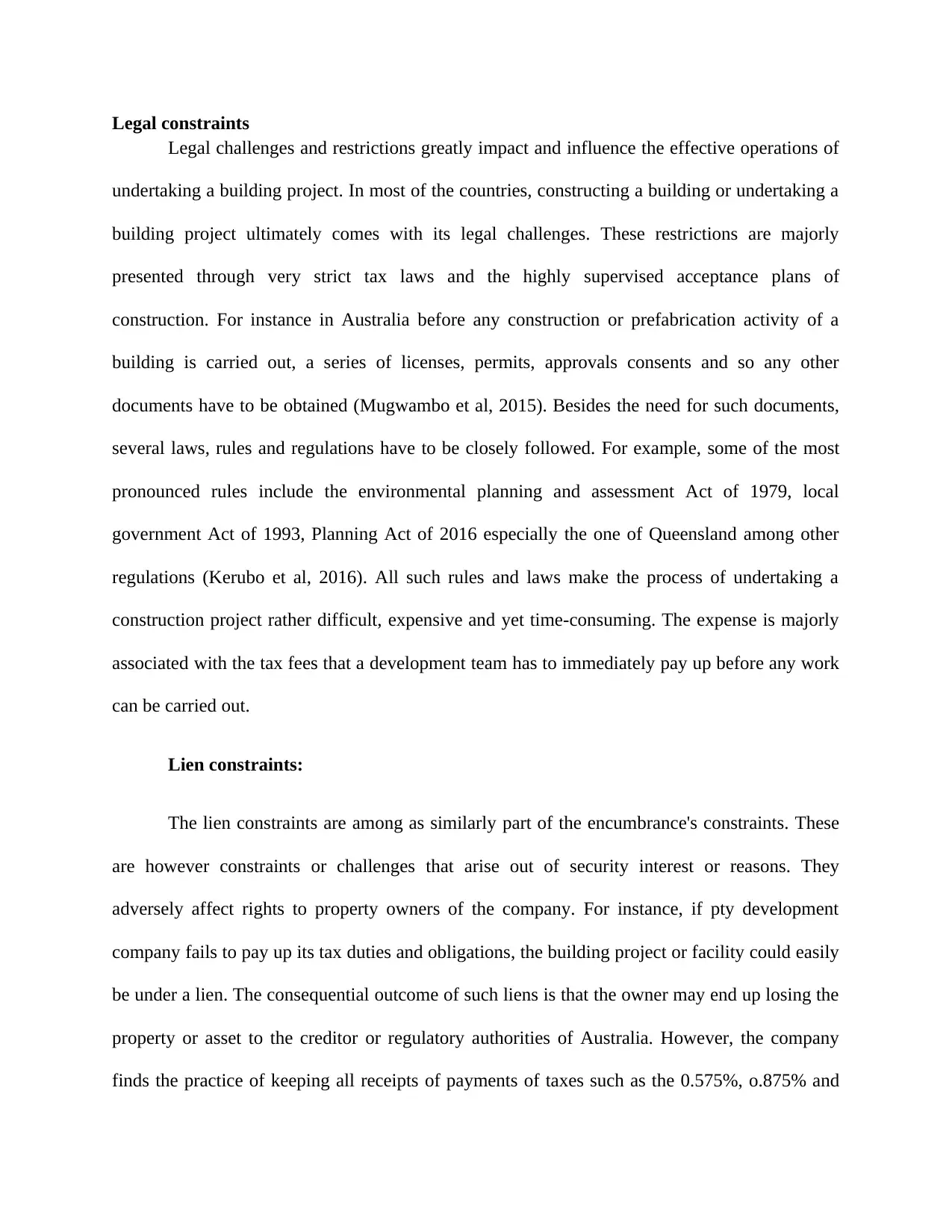
Legal constraints
Legal challenges and restrictions greatly impact and influence the effective operations of
undertaking a building project. In most of the countries, constructing a building or undertaking a
building project ultimately comes with its legal challenges. These restrictions are majorly
presented through very strict tax laws and the highly supervised acceptance plans of
construction. For instance in Australia before any construction or prefabrication activity of a
building is carried out, a series of licenses, permits, approvals consents and so any other
documents have to be obtained (Mugwambo et al, 2015). Besides the need for such documents,
several laws, rules and regulations have to be closely followed. For example, some of the most
pronounced rules include the environmental planning and assessment Act of 1979, local
government Act of 1993, Planning Act of 2016 especially the one of Queensland among other
regulations (Kerubo et al, 2016). All such rules and laws make the process of undertaking a
construction project rather difficult, expensive and yet time-consuming. The expense is majorly
associated with the tax fees that a development team has to immediately pay up before any work
can be carried out.
Lien constraints:
The lien constraints are among as similarly part of the encumbrance's constraints. These
are however constraints or challenges that arise out of security interest or reasons. They
adversely affect rights to property owners of the company. For instance, if pty development
company fails to pay up its tax duties and obligations, the building project or facility could easily
be under a lien. The consequential outcome of such liens is that the owner may end up losing the
property or asset to the creditor or regulatory authorities of Australia. However, the company
finds the practice of keeping all receipts of payments of taxes such as the 0.575%, o.875% and
Legal challenges and restrictions greatly impact and influence the effective operations of
undertaking a building project. In most of the countries, constructing a building or undertaking a
building project ultimately comes with its legal challenges. These restrictions are majorly
presented through very strict tax laws and the highly supervised acceptance plans of
construction. For instance in Australia before any construction or prefabrication activity of a
building is carried out, a series of licenses, permits, approvals consents and so any other
documents have to be obtained (Mugwambo et al, 2015). Besides the need for such documents,
several laws, rules and regulations have to be closely followed. For example, some of the most
pronounced rules include the environmental planning and assessment Act of 1979, local
government Act of 1993, Planning Act of 2016 especially the one of Queensland among other
regulations (Kerubo et al, 2016). All such rules and laws make the process of undertaking a
construction project rather difficult, expensive and yet time-consuming. The expense is majorly
associated with the tax fees that a development team has to immediately pay up before any work
can be carried out.
Lien constraints:
The lien constraints are among as similarly part of the encumbrance's constraints. These
are however constraints or challenges that arise out of security interest or reasons. They
adversely affect rights to property owners of the company. For instance, if pty development
company fails to pay up its tax duties and obligations, the building project or facility could easily
be under a lien. The consequential outcome of such liens is that the owner may end up losing the
property or asset to the creditor or regulatory authorities of Australia. However, the company
finds the practice of keeping all receipts of payments of taxes such as the 0.575%, o.875% and
Paraphrase This Document
Need a fresh take? Get an instant paraphrase of this document with our AI Paraphraser
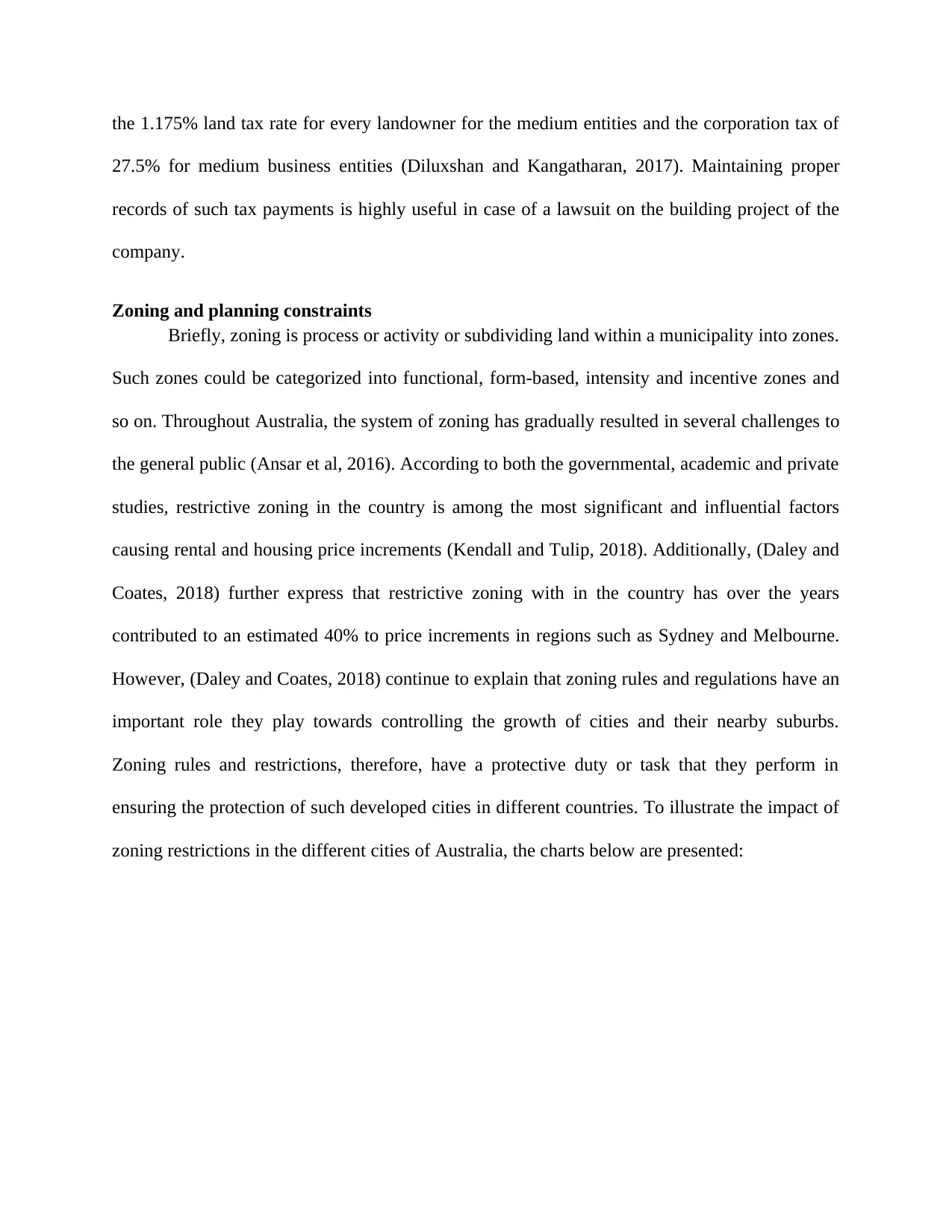
the 1.175% land tax rate for every landowner for the medium entities and the corporation tax of
27.5% for medium business entities (Diluxshan and Kangatharan, 2017). Maintaining proper
records of such tax payments is highly useful in case of a lawsuit on the building project of the
company.
Zoning and planning constraints
Briefly, zoning is process or activity or subdividing land within a municipality into zones.
Such zones could be categorized into functional, form-based, intensity and incentive zones and
so on. Throughout Australia, the system of zoning has gradually resulted in several challenges to
the general public (Ansar et al, 2016). According to both the governmental, academic and private
studies, restrictive zoning in the country is among the most significant and influential factors
causing rental and housing price increments (Kendall and Tulip, 2018). Additionally, (Daley and
Coates, 2018) further express that restrictive zoning with in the country has over the years
contributed to an estimated 40% to price increments in regions such as Sydney and Melbourne.
However, (Daley and Coates, 2018) continue to explain that zoning rules and regulations have an
important role they play towards controlling the growth of cities and their nearby suburbs.
Zoning rules and restrictions, therefore, have a protective duty or task that they perform in
ensuring the protection of such developed cities in different countries. To illustrate the impact of
zoning restrictions in the different cities of Australia, the charts below are presented:
27.5% for medium business entities (Diluxshan and Kangatharan, 2017). Maintaining proper
records of such tax payments is highly useful in case of a lawsuit on the building project of the
company.
Zoning and planning constraints
Briefly, zoning is process or activity or subdividing land within a municipality into zones.
Such zones could be categorized into functional, form-based, intensity and incentive zones and
so on. Throughout Australia, the system of zoning has gradually resulted in several challenges to
the general public (Ansar et al, 2016). According to both the governmental, academic and private
studies, restrictive zoning in the country is among the most significant and influential factors
causing rental and housing price increments (Kendall and Tulip, 2018). Additionally, (Daley and
Coates, 2018) further express that restrictive zoning with in the country has over the years
contributed to an estimated 40% to price increments in regions such as Sydney and Melbourne.
However, (Daley and Coates, 2018) continue to explain that zoning rules and regulations have an
important role they play towards controlling the growth of cities and their nearby suburbs.
Zoning rules and restrictions, therefore, have a protective duty or task that they perform in
ensuring the protection of such developed cities in different countries. To illustrate the impact of
zoning restrictions in the different cities of Australia, the charts below are presented:
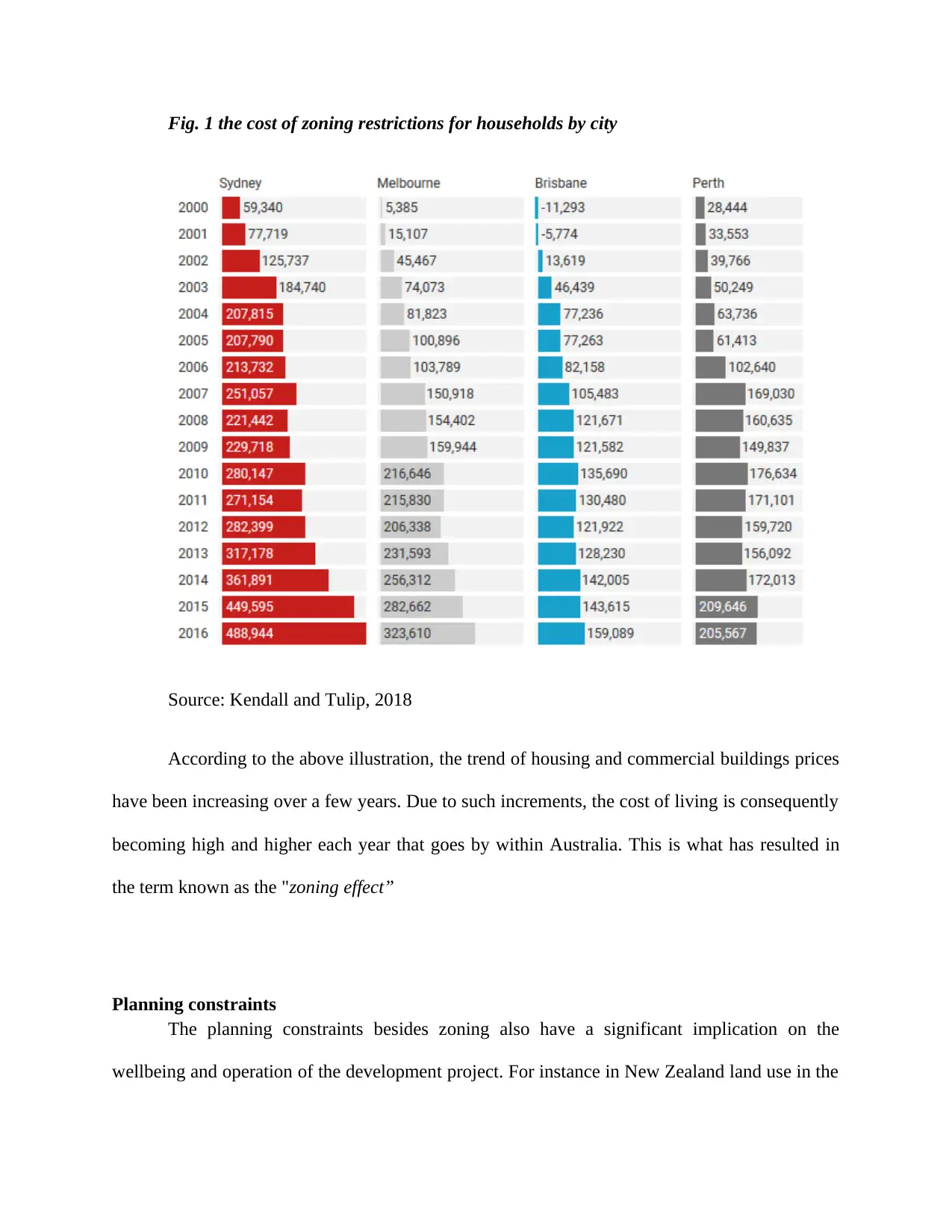
Fig. 1 the cost of zoning restrictions for households by city
Source: Kendall and Tulip, 2018
According to the above illustration, the trend of housing and commercial buildings prices
have been increasing over a few years. Due to such increments, the cost of living is consequently
becoming high and higher each year that goes by within Australia. This is what has resulted in
the term known as the "zoning effect”
Planning constraints
The planning constraints besides zoning also have a significant implication on the
wellbeing and operation of the development project. For instance in New Zealand land use in the
Source: Kendall and Tulip, 2018
According to the above illustration, the trend of housing and commercial buildings prices
have been increasing over a few years. Due to such increments, the cost of living is consequently
becoming high and higher each year that goes by within Australia. This is what has resulted in
the term known as the "zoning effect”
Planning constraints
The planning constraints besides zoning also have a significant implication on the
wellbeing and operation of the development project. For instance in New Zealand land use in the
⊘ This is a preview!⊘
Do you want full access?
Subscribe today to unlock all pages.

Trusted by 1+ million students worldwide
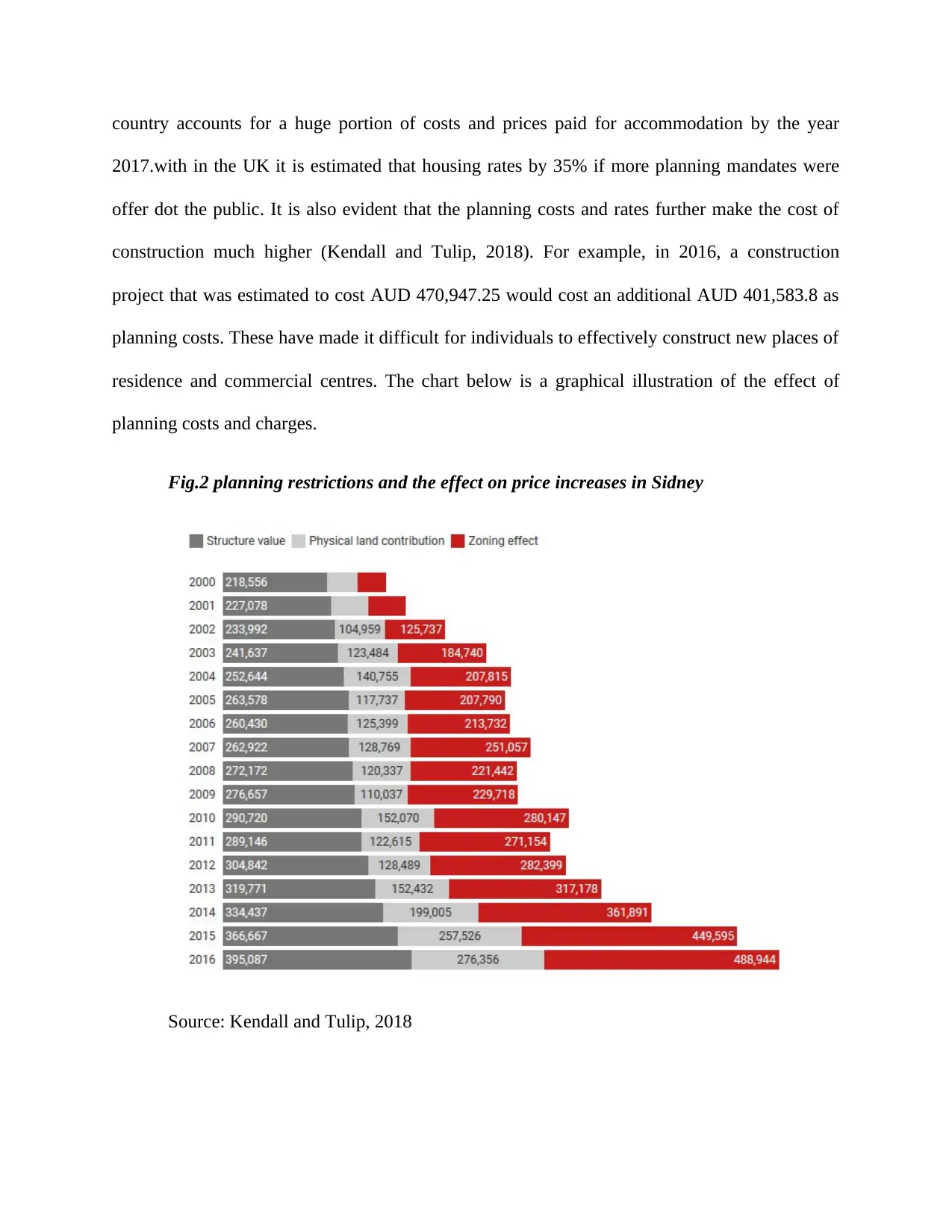
country accounts for a huge portion of costs and prices paid for accommodation by the year
2017.with in the UK it is estimated that housing rates by 35% if more planning mandates were
offer dot the public. It is also evident that the planning costs and rates further make the cost of
construction much higher (Kendall and Tulip, 2018). For example, in 2016, a construction
project that was estimated to cost AUD 470,947.25 would cost an additional AUD 401,583.8 as
planning costs. These have made it difficult for individuals to effectively construct new places of
residence and commercial centres. The chart below is a graphical illustration of the effect of
planning costs and charges.
Fig.2 planning restrictions and the effect on price increases in Sidney
Source: Kendall and Tulip, 2018
2017.with in the UK it is estimated that housing rates by 35% if more planning mandates were
offer dot the public. It is also evident that the planning costs and rates further make the cost of
construction much higher (Kendall and Tulip, 2018). For example, in 2016, a construction
project that was estimated to cost AUD 470,947.25 would cost an additional AUD 401,583.8 as
planning costs. These have made it difficult for individuals to effectively construct new places of
residence and commercial centres. The chart below is a graphical illustration of the effect of
planning costs and charges.
Fig.2 planning restrictions and the effect on price increases in Sidney
Source: Kendall and Tulip, 2018
Paraphrase This Document
Need a fresh take? Get an instant paraphrase of this document with our AI Paraphraser
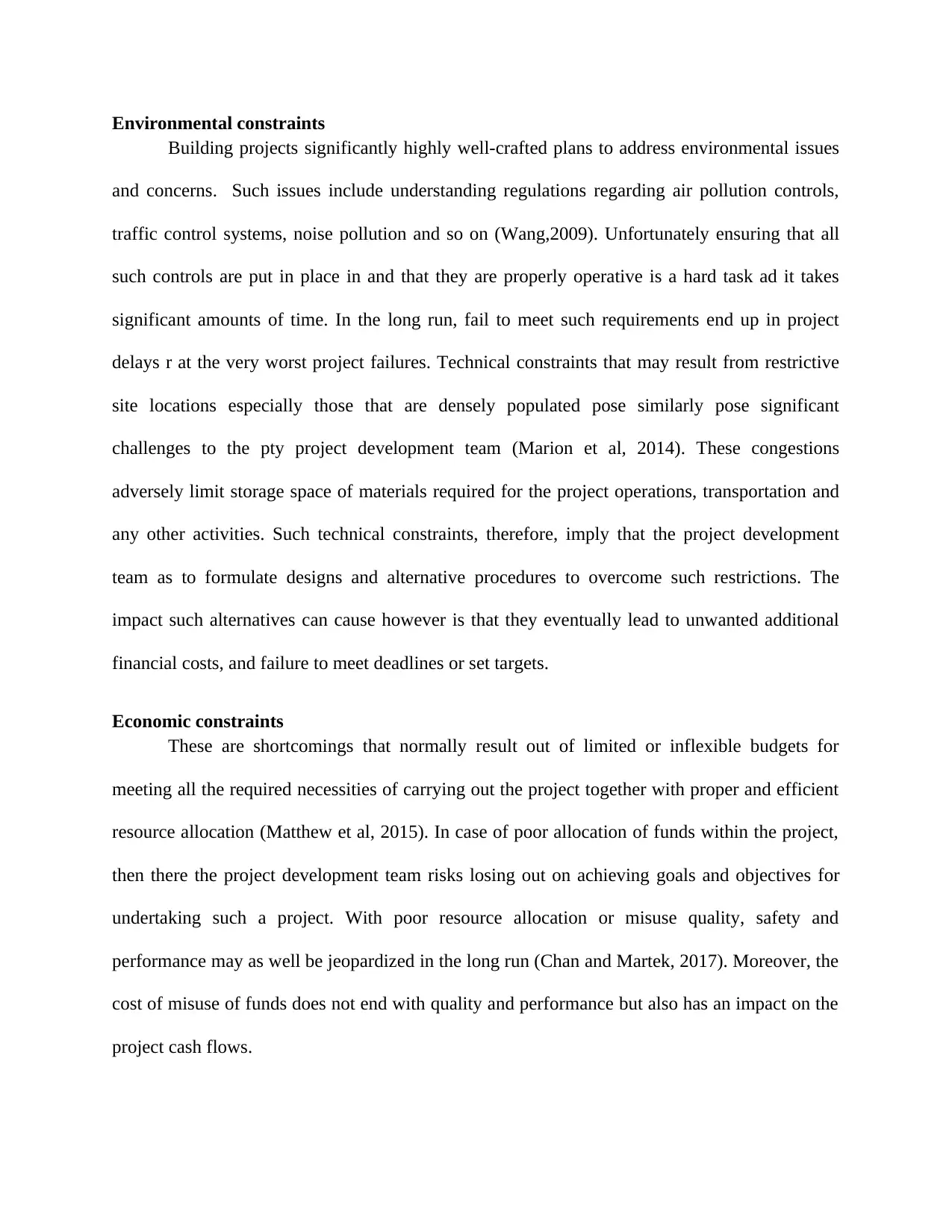
Environmental constraints
Building projects significantly highly well-crafted plans to address environmental issues
and concerns. Such issues include understanding regulations regarding air pollution controls,
traffic control systems, noise pollution and so on (Wang,2009). Unfortunately ensuring that all
such controls are put in place in and that they are properly operative is a hard task ad it takes
significant amounts of time. In the long run, fail to meet such requirements end up in project
delays r at the very worst project failures. Technical constraints that may result from restrictive
site locations especially those that are densely populated pose similarly pose significant
challenges to the pty project development team (Marion et al, 2014). These congestions
adversely limit storage space of materials required for the project operations, transportation and
any other activities. Such technical constraints, therefore, imply that the project development
team as to formulate designs and alternative procedures to overcome such restrictions. The
impact such alternatives can cause however is that they eventually lead to unwanted additional
financial costs, and failure to meet deadlines or set targets.
Economic constraints
These are shortcomings that normally result out of limited or inflexible budgets for
meeting all the required necessities of carrying out the project together with proper and efficient
resource allocation (Matthew et al, 2015). In case of poor allocation of funds within the project,
then there the project development team risks losing out on achieving goals and objectives for
undertaking such a project. With poor resource allocation or misuse quality, safety and
performance may as well be jeopardized in the long run (Chan and Martek, 2017). Moreover, the
cost of misuse of funds does not end with quality and performance but also has an impact on the
project cash flows.
Building projects significantly highly well-crafted plans to address environmental issues
and concerns. Such issues include understanding regulations regarding air pollution controls,
traffic control systems, noise pollution and so on (Wang,2009). Unfortunately ensuring that all
such controls are put in place in and that they are properly operative is a hard task ad it takes
significant amounts of time. In the long run, fail to meet such requirements end up in project
delays r at the very worst project failures. Technical constraints that may result from restrictive
site locations especially those that are densely populated pose similarly pose significant
challenges to the pty project development team (Marion et al, 2014). These congestions
adversely limit storage space of materials required for the project operations, transportation and
any other activities. Such technical constraints, therefore, imply that the project development
team as to formulate designs and alternative procedures to overcome such restrictions. The
impact such alternatives can cause however is that they eventually lead to unwanted additional
financial costs, and failure to meet deadlines or set targets.
Economic constraints
These are shortcomings that normally result out of limited or inflexible budgets for
meeting all the required necessities of carrying out the project together with proper and efficient
resource allocation (Matthew et al, 2015). In case of poor allocation of funds within the project,
then there the project development team risks losing out on achieving goals and objectives for
undertaking such a project. With poor resource allocation or misuse quality, safety and
performance may as well be jeopardized in the long run (Chan and Martek, 2017). Moreover, the
cost of misuse of funds does not end with quality and performance but also has an impact on the
project cash flows.
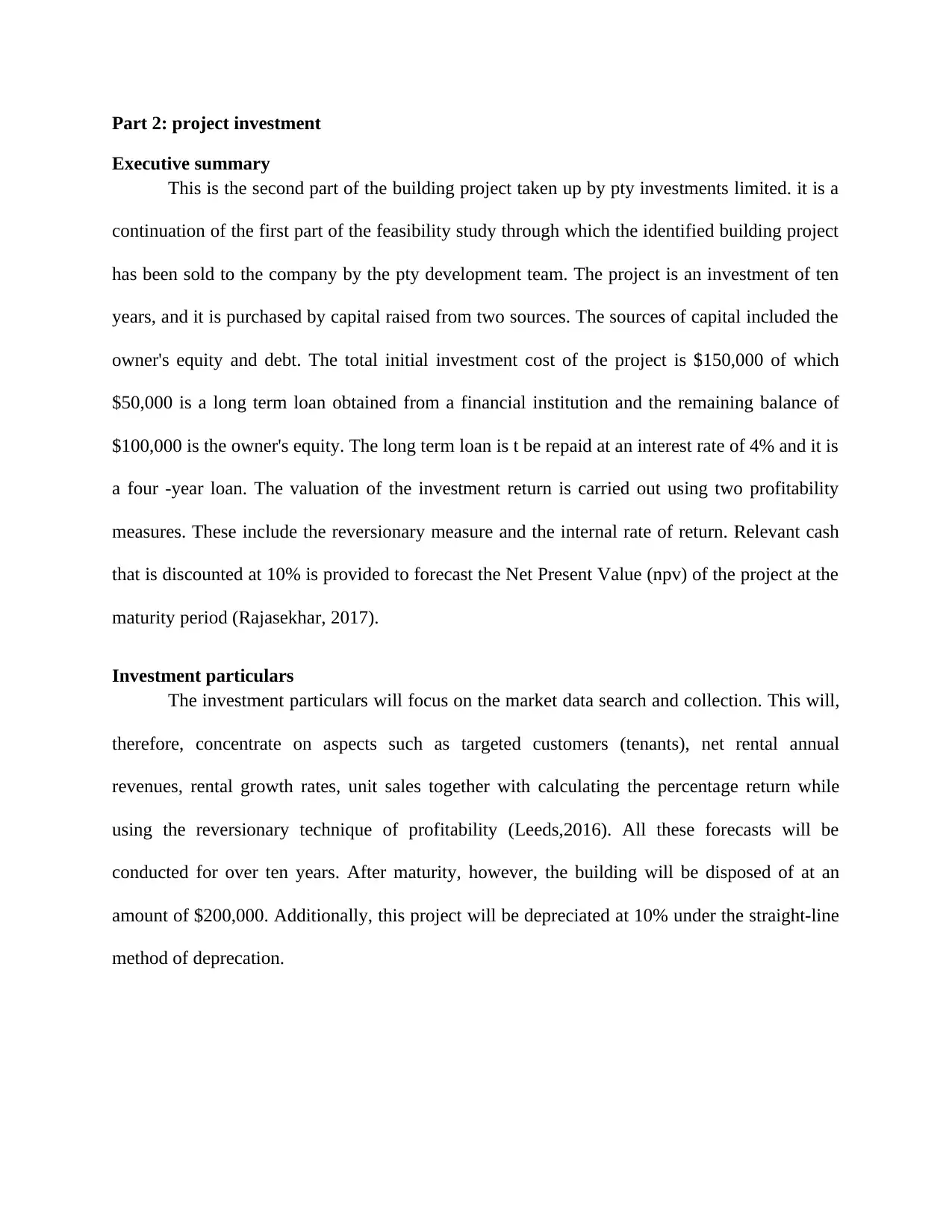
Part 2: project investment
Executive summary
This is the second part of the building project taken up by pty investments limited. it is a
continuation of the first part of the feasibility study through which the identified building project
has been sold to the company by the pty development team. The project is an investment of ten
years, and it is purchased by capital raised from two sources. The sources of capital included the
owner's equity and debt. The total initial investment cost of the project is $150,000 of which
$50,000 is a long term loan obtained from a financial institution and the remaining balance of
$100,000 is the owner's equity. The long term loan is t be repaid at an interest rate of 4% and it is
a four -year loan. The valuation of the investment return is carried out using two profitability
measures. These include the reversionary measure and the internal rate of return. Relevant cash
that is discounted at 10% is provided to forecast the Net Present Value (npv) of the project at the
maturity period (Rajasekhar, 2017).
Investment particulars
The investment particulars will focus on the market data search and collection. This will,
therefore, concentrate on aspects such as targeted customers (tenants), net rental annual
revenues, rental growth rates, unit sales together with calculating the percentage return while
using the reversionary technique of profitability (Leeds,2016). All these forecasts will be
conducted for over ten years. After maturity, however, the building will be disposed of at an
amount of $200,000. Additionally, this project will be depreciated at 10% under the straight-line
method of deprecation.
Executive summary
This is the second part of the building project taken up by pty investments limited. it is a
continuation of the first part of the feasibility study through which the identified building project
has been sold to the company by the pty development team. The project is an investment of ten
years, and it is purchased by capital raised from two sources. The sources of capital included the
owner's equity and debt. The total initial investment cost of the project is $150,000 of which
$50,000 is a long term loan obtained from a financial institution and the remaining balance of
$100,000 is the owner's equity. The long term loan is t be repaid at an interest rate of 4% and it is
a four -year loan. The valuation of the investment return is carried out using two profitability
measures. These include the reversionary measure and the internal rate of return. Relevant cash
that is discounted at 10% is provided to forecast the Net Present Value (npv) of the project at the
maturity period (Rajasekhar, 2017).
Investment particulars
The investment particulars will focus on the market data search and collection. This will,
therefore, concentrate on aspects such as targeted customers (tenants), net rental annual
revenues, rental growth rates, unit sales together with calculating the percentage return while
using the reversionary technique of profitability (Leeds,2016). All these forecasts will be
conducted for over ten years. After maturity, however, the building will be disposed of at an
amount of $200,000. Additionally, this project will be depreciated at 10% under the straight-line
method of deprecation.
⊘ This is a preview!⊘
Do you want full access?
Subscribe today to unlock all pages.

Trusted by 1+ million students worldwide
1 out of 22
Related Documents
Your All-in-One AI-Powered Toolkit for Academic Success.
+13062052269
info@desklib.com
Available 24*7 on WhatsApp / Email
![[object Object]](/_next/static/media/star-bottom.7253800d.svg)
Unlock your academic potential
Copyright © 2020–2025 A2Z Services. All Rights Reserved. Developed and managed by ZUCOL.




